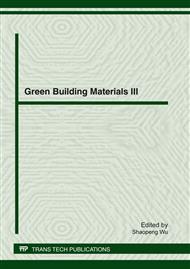[1]
M.F. Bertos, S.J.R. Simons, C.D. Hills, et al, A Review of Accelerated Carbonation Technology in the Treatment of Cement-based Materials and Sequestration of CO2, J. J Hazard Mater. B112 (2004) 193-205.
DOI: 10.1016/j.jhazmat.2004.04.019
Google Scholar
[2]
D.N. Huntzinger, J.S. Gierke, L.L. Sutter, et al, Mineral Carbonation for Carbon Sequestration in Cement Kiln Dust from Waste Piles, J. J Hazard Mater. 168 (2009) 31-37.
DOI: 10.1016/j.jhazmat.2009.01.122
Google Scholar
[3]
J.C. Picot, D. Cassard, F. Maldan, et al, Worldwide Potential for Ex-situ Mineral Carbonation, J. Energy Procedia. 4 (2011) 2971-2977.
DOI: 10.1016/j.egypro.2011.02.206
Google Scholar
[4]
B. Bonfils, F. Bourgeois, C. Julcour, et al, Understanding the Chemistry of Direct Aqueous Carbonation with Additives through Geochemical Modeling, J. Energy Procedia. 4 (2011) 3809-3816.
DOI: 10.1016/j.egypro.2011.02.316
Google Scholar
[5]
C.J. Shi, P.V. Krivenko, D. Roy, Alkali-activated cements and concretes, Taylor & Francis, New York, 2006, pp.44-51.
DOI: 10.4324/9780203390672
Google Scholar
[6]
C. Kunzler, N. Alves, E. Pereira, et al, CO2 Storage with Indirect Carbonation Using Industrial Waste, J. Energy Procedia. 4 (2011) 1010-1017.
DOI: 10.1016/j.egypro.2011.01.149
Google Scholar
[7]
A. Van Zomeren, S.R. Van der Laan, H.B.A. Kobesen, et al, Changes in Mineralogical and Leaching Properties of Converter Steel Slag Resulting from Accelerated Carbonation at Low CO2 Pressure, J. Waste Manage. 31 (2011) 2236-2244.
DOI: 10.1016/j.wasman.2011.05.022
Google Scholar
[8]
R. Baciocchi, G. Costa, A. Polettini, et al, Influence of Particle Size on the Carbonation of Stainless Steel Slag for CO2 Storage, J. Energy Procedia. 4 (2011) 4985-4992.
DOI: 10.1016/j.egypro.2009.02.314
Google Scholar
[9]
R. Baciocchi, G. Costa, E.D. Bartolomeo, et al, Carbonation of Stainless Steel Slag as a Process for CO2 Storage and Slag Valorization, J. Waste Biomass Valor. 1 (2010) 467-477.
DOI: 10.1007/s12649-010-9047-1
Google Scholar
[10]
N.R. Yang, W.H. Yue. The Handbook of Inorganic Matalloid Materials Atlas, Wuhan University of Technology Press, Wuhan, 2000, pp.201-406.
Google Scholar
[11]
CH.F. Chang, J.W. Chen, The Experimental Investigation of Concrete Carbonation Depth, J. Cement Concrete Res. 36 (2006) 1760-1767.
DOI: 10.1016/j.cemconres.2004.07.025
Google Scholar
[12]
E.E. Chang, CH.H Chen, Y.H. Chen, et al, Performance Evaluation for Carbonation of Steel-making Slags in a Slurry Reactor, J. J Hazard Mater. 186 (2011) 558-564.
DOI: 10.1016/j.jhazmat.2010.11.038
Google Scholar
[13]
T. Van Gerven, G. Cornelis, E. Vandoren, et al, Effects of Carbonation and Leaching on Porosity in Cement-bound Waste, J. Waste Manage. 27 (2007) 977-985.
DOI: 10.1016/j.wasman.2006.05.008
Google Scholar
[14]
P. Pipilikaki, M. Beazi-Katsioti, The Assessment of Porosity and Pore Size Distribution of Limestone Portland Cement Pastes, J. Constr Build Mater. 23 (2009) 1966-1970.
DOI: 10.1016/j.conbuildmat.2008.08.028
Google Scholar


